Investing in real estate usually starts with one question: What kind of property should you invest in? When it comes to investing in housing, multifamily properties are a very popular choice. A multifamily property is either a building with more than one residential unit or a group of residential buildings in a complex.
Investors prize multifamily properties for their strong cash flow and lower vacancy rates. When a tenant moves out of a single-family home, the property is 100 percent vacant. The landlord will have to pay the mortgage and all other expenses out-of-pocket until there’s a new tenant. With a multifamily dwelling, one tenant’s departure would result in a 25 percent vacancy rate in a quadplex and a one percent rate in a 100-unit apartment building. That landlord still has 75 percent or 99 percent, respectively, of rental income while one unit is vacant.
Convenience and scalability are other benefits of investing in multifamily properties. An investor who wants to receive 10 streams of monthly rental income could rent out 10 single-family homes. That investor has 10 roofs to maintain, went through 10 real estate transactions, and may need to travel between 10 properties. A single 10-unit apartment building reaches the same goal with one roof, one real estate transaction, and one place to drive to.
New investors may find the easiest way to start investing in multifamily dwellings is to purchase a property with two to four units. Investors who plan to live in one of the units can count the property’s rental income to qualify for the loan. These small multifamily dwellings are easy to finance because lenders usually use the same standards as they do for single-family homes. In contrast, commercial lending standards apply for properties with more than five units. Commercial real estate loans have higher interest rates, require bigger down payments, and have shorter terms than residential home loans.
Successful investors in multifamily properties regard location as king and queen. Many real estate investors rank neighborhoods from best to worst with the letters A, B, C, or D. New multifamily investors may want to avoid properties in D-class neighborhoods because finding good tenants to live in those areas could prove impossible.
Investors should conduct their own research to determine potential rental income instead of relying on numbers provided by the seller. Knowing the income potential helps investors decide if the property should provide positive cash flow after expenses. Hiring a property manager could be one of those expenses for investors who don’t want the headaches of dealing with multiple tenants.

